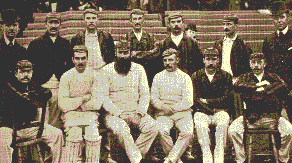A champion team is almost always going to trump (sorry)
overcome a team of champions
Got room for my mates too?
Sure ... well, for seven of them at least.
As mentioned earlier, the standard number of players in a team is eight. When batting, each batting pair face 4 overs. Each player bowls 2 overs. An innings therefore consists of 16 overs, and a game consists of each team fielding for one innings and batting for one innings. Games usually last between 75 and 90 minutes.
And your mates can be of any gender of course - there are even formal "mixed" games. In this very popular case, four men and four women make up a team. There are one or two modified rules for 'mixed' competitions, covered under the "Rules" section. It should be noted that there are many women playing in regular competitions (that is, against all-men teams) around the country - and the egos of many a male player has been shattered by the realisation that there are some very VERY handy women indoor-cricketers around.
As you can see, Indoor-Cricket is a particularly 'democratic' version of the game - every player bowls 2 overs, and every player bats for 4 overs.
Typically, a fielding side has a traditional wicket-keeper, the only player under normal circumstances allowed to wear gloves when fielding. He/she also bowls 2 overs and bats for 4, the same as every other member of the team.
There is almost always a "back-stumper" - a fielder whose main responsibility is to take return throws to the non-strikers' stumps. The rest of the field is usually positioned evenly about the court.
There are sometimes variations on the above - some centres which have courts smaller than the standard will play six-a-side games. These games sometimes have other variations, such as only losing 3 runs for each wicket. However these are truly the exception, and are generally seen to be a compromise on the norm, if only for the fact that the game is being played on a smaller-than-standard court.
Once again, further detail can be found in "The Rules".
